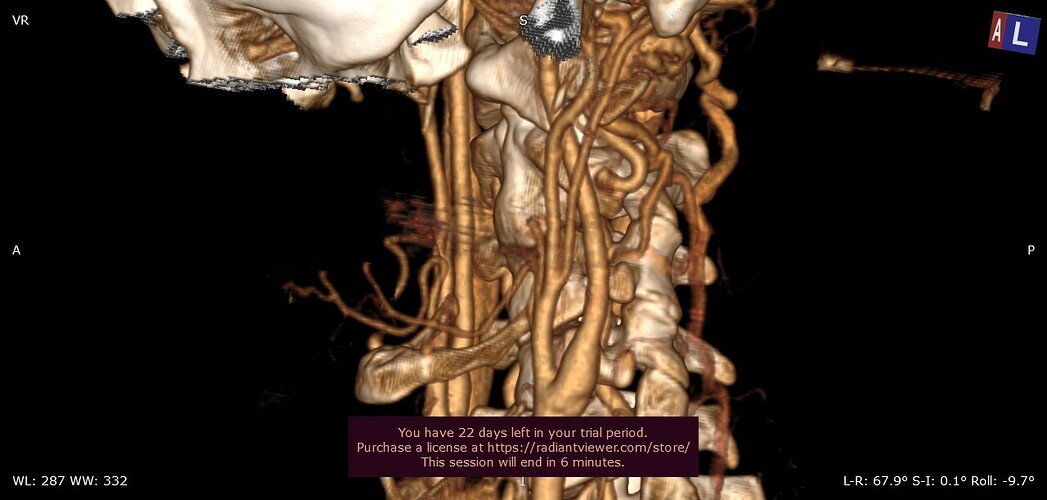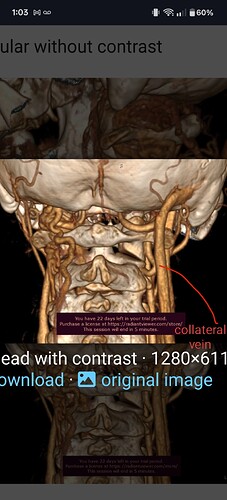Greetings to all…
I have received such a kind welcome, read several posts and guides, and am learning so much already. I have hopefully captured the most relevant 3d images from my recent CTA with venogram protocol using Radiant and will share those here.
My symptoms began over 3 years ago and I have been on quite the roller coaster since. I have received multiple diagnoses. There are still other diagnoses I suspect, but are unconfirmed so far. I had a relatively pain-free life prior to the start of all this, which I am grateful for.
My first alarming symptoms began in March of 2022, seemingly out of nowhere in my sleep one night. There was no precipitating event. Then began a cascade of more symptoms that unfolded over the next several months. I have seen many specialists and had an abundance of testing. Everything scary has been ruled out. Here is where things stand currently. The only head/neck imaging findings have been “Marked developmental hypoplasia of the right transverse and sigmoid sinuses” and a “non-symptomatic congenital small right internal carotid artery web.”
Left-sided Thoracic Outlet Syndrome - diagnosed by vascular, managed initially with PT, and continued conservative management via avoidance of aggravating positions and maneuvers. I sleep on an incline on my right side with my left arm wrapped around a pillow in front of me. This has probably helped my TOS the most.
Left-sided joint pain in my left knee, foot, elbow, hand. Worst at night. Helped by taking a Boswellia supplement daily. Inflammation blood markers were negative two years ago. I was also tested then for Sjogren’s antibodies, which were negative. I have recently requested updated testing and a rheumatology referral.
Suspected Non-length dependent Small Fiber Neuropathy - I have altered sensation on the entire left side of my body… it is slightly numb from head to toe. Normal EMG’s. No signs of MS. The slight numbness doesn’t bother me much and I haven’t pursued confirmation via skin punch biopsy yet. I also get left-sided burning nerve pain at night. The daily boswellia taken for joint pain also seems to help with the burning pain.
Constant chronic pain in the back of my head and neck. Head pressure, worsened when laying flat. Tenderness in the back of my head aggravated by even the softest of pillows. I had a lumbar puncture 2 years ago with an opening pressure of 23, not quite IIH, but still elevated (normal is considered below 20). No papilledema and no other signs of IIH on MRI. I had injections diagnostic of Occipital Neuralgia, unfortunately only the few hours of lidocaine helped, but the steroid did not. Neither physical therapy nor dry needling helped. Finally tried Dandelion root (a mild diuretic) and found significant relief, though not full relief. Lidocaine roll-on does help my neck also. Ice helps as needed. Sometimes heat as well. Sometimes Tylenol but I try not to take it more than a few times per week. Edit: And now aspirin (which I accidentally discovered, see the section about May-Thurner Syndrome below). I also just thought to add something else about my head/neck pain… My symptoms worsen when looking down in neck flexion. Neck extension sometimes provides relief. My symptoms also worsen when my head is in a static position for long, like using the computer, attending a performance where the audience is expected to be still, sleeping, etc. My symptoms improve when I’m walking or exercising, staying active in some way, although if I overdo my activity, I also pay for that later.
May-Thurner Syndrome and pelvic congestion syndrome. Received a left iliac vein stent for 88% compression this January. This has relieved chronic groin pain on the left and right, chronic lower back pain, and chronic pelvic heaviness. Starting the day of my stent, my head and neck pain were also gone. Unfortunately I found out it was the post-stent blood thinners that were helping my head/neck, and not the stent itself. I couldn’t tolerate Eliquis (it was tanking my blood pressure) so was dropped to 325 mg aspirin. A month later I was cleared to drop to baby aspirin. Soon my head/neck pain were back in full force. This discovery prompted my most recent imaging. Then went back to dandelion root which wasn’t helping for a while. Got cleared to increase the aspirin dose back up, so went to 3 baby aspirins/day. It did help, but seems to have lost some effectiveness. Currently trialing both dandelion root + 2-3 baby aspirin. Seems to be more effective than one or the other, but still not great.
Dull achy lower jaw pain - this is more recent for me. Started in late April, is not constant. Lidocaine roll-on helps.
After learning more about Eagle Syndrome anatomy, the hyoid bone, etc, I have been palpating areas under my lower jaw. There are a few tender spots, I haven’t figured out what they are. Possibly salivary glands, but one seems too low for that. The most acute tenderness is a spot left of center seemlingly near hyoid level.
Lastly, I have had pulsatile tinnitus during sleep at times. It has come on for weeks on end in one ear, then nothing for a while, then in both ears for weeks, then nothing again. I do not seem to be having it for the last couple months.
Okay, now for my images. I know I have segmented calcified stylohyoid ligaments. I believe the right one is touching my external carotid artery, or is that a different vessel? I believe the right side of my hyoid is also touching vessels. The supposed developmental hypoplasia of my left jugular apparently causes it to “disappear” when contrast is used. My right jugular does narrow some at C1 and then widen again, but I guess not enough for a radiologist to care? And I believe I have collateral vessels on the left, which looks quite different from the right side.
I am so curious to hear your opinions. From my reading here so far, you are all incredibly knowledgeable and helpful. I greatly appreciate any insight you’re able to provide. Thank you!
Both calcified ligaments
right jugular with contrast
right jugular without contrast
left calcified ligament with contrast “missing” jugular
left jugular without contrast
back of head with contrast
right hyoid view
left hyoid view
hyoid from above
hyoid from below












